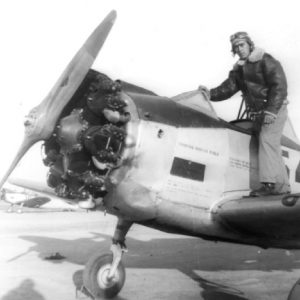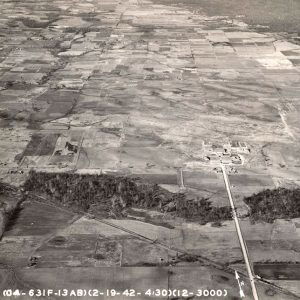calsfoundation@cals.org
Thompson-Robbins Air Field
aka: Helena Aero Tech
In about 1940, the United States was planning a build-up in the strength of the Army Air Corps (later the Army Air Force, or AAF). The number of airplanes produced was to be increased to around 50,000, but the AAF’s flying school in Texas could only graduate 500 pilots a year, and most of the current AAF pilots did not have enough flying hours to be instructors. To produce more pilots, the commanding general of the AAF, Henry Arnold, devised a plan for primary contract flying schools located in local communities.
Three primary contract flying schools were located in Arkansas: the first at Grider Field in Pine Bluff (Jefferson County), the second at Thompson-Robbins Airfield in West Helena (Phillips County), and the third at Harrell Field in Camden (Ouachita County). The contractors were responsible for constructing the buildings, hiring flight instructors, supplying mechanics, providing housing and food, and maintaining the planes. The AAF would supply the trainees and planes, pay for the training, and buy back the buildings after the schools closed. Local communities often furnished the land. The schools were a boon for local communities, as they supplied employment for area residents during construction and operations.
The cities of Helena (Phillips County) and West Helena acquired 640 acres of land adjoining the existing airport at West Helena for the school. Two auxiliary airfields were built from five to seven miles away. William R. Kent and Bertrand W. Cohn, contractors for the Pine Bluff school, joined with Rudolph Van Devere of Akron Airways to establish the Helena school. They activated the school as Helena Aero Tech on October 4, 1941. The first class of the Fifty-ninth AAF Flying Training Detachment arrived on October 5, 1941. The airfield was dedicated as the Thompson-Robbins Airfield on December 6, 1941, in honor of two Helena flyers killed in AAF flying accidents: Lieutenant Jerome Pillow Thompson, who died on June 17, 1933, and Lieutenant Jack Stewart Robbins, who died on November 8, 1940.
Between January 1941 and August 1945, nearly 325,000 men entered AAF training nationwide, but approximately forty percent did not finish the rigorous training due to inability to complete the requirements or to death in training accidents. Trainees could wash out in any phase of the training program. To become an AAF pilot, a man first went to the nearest Aviation Cadet Examining Board. The potential cadet was given mental and physical examinations, and, if qualified, he was given a letter to the Armed Forces Induction Station. At first, potential trainees were sent directly to pre-flight school after induction, but by the spring of 1943 a college phase was introduced before pre-flight school. The college phase consisted of three to five months of courses in academic and military subjects. AAF officers were responsible for the military indoctrination that all new army inductees had to complete. Several colleges around Arkansas participated in the AAF college phase.
After completing the college phase, would-be airmen were sent to a classification center where they were given extensive physical and mental testing for two to four weeks. At the completion of classification, the graduates classified as pilot trainees went to a nine-week program at pre-flight school.
After pre-flight, the cadet went to primary flight training schools such as the school at Thompson-Robbins Airfield. In this nine-week program, the cadets had seventy hours of flight training in two-seater aircraft such as the Fairchild PT-19. When not in flight training, the cadets attended ground school classes. Cadets graduating from primary flight training went on to basic flying schools such as the two basic training schools located at Walnut Ridge (Lawrence County) and Newport (Jackson County). After completion of basic flight training, the cadets went on to advanced schools such as the schools at Stuttgart (Arkansas County) and Blytheville (Mississippi County). Graduates from the advanced schools became AAF pilots.
By the spring of 1944 the AAF reported that training in the aviation cadet program was ahead of schedule and that the program would be suspended. During operations, 3,985 student pilots graduated from the school at Thompson-Robbins. On August 4, 1944, the Arkansas Gazette announced that training at Helena airfield was completed and that the planes and furniture of the school were to be sold at auction. After the close of World War II, the airfield returned to civilian control. It remains in use as Thompson-Robbins Airport.
For additional information:
Hope, Holly. “We’ve Gotta Get Tough: History of World War II Home Front Efforts in Arkansas, 1941–1945.” Little Rock: Arkansas Historic Preservation Program, 2008. Online at https://www.arkansasheritage.com/arkansas-historic-preservation-program (accessed April 25, 2023).
Johnson, Harold, compiler. The History of the Walnut Ridge Army Air Field. Walnut Ridge, AR: Walnut Ridge Army Flying School Museum, 2006.
Carolyn Yancey Kent
Jacksonville, Arkansas

 Aero Tech Graduation
Aero Tech Graduation  Aero Tech Map
Aero Tech Map  Airmen
Airmen  Cadet Pilot
Cadet Pilot  Helena Aero Tech
Helena Aero Tech  Helena Aero Tech
Helena Aero Tech  Helena Aero Tech Buildings
Helena Aero Tech Buildings  Helena Air Field
Helena Air Field 



I really enjoyed reading this. I knew my grandfather, Rudolph Van Devere, had built a field in Arkansas. It is nice to see his contributions recorded.
Famous aviation legend Robert A. “Bob” Hoover was based at Thompson-Robbins Air Field (before it was named that) for primary PT-19 training, according to his book Forever Flying: Fifty Years of High-flying Adventures, From Barnstorming in Prop Planes to Dogfighting Germans to Testing Supersonic Jets, An Autobiography.